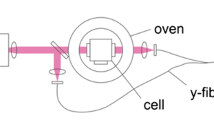Abstract
PREVIOUS investigations concerning the quantitative determination of the 3,4-benzopyrene content of the air by fluorescence emission spectroscopy1 showed that the fluorescence intensity of the samples exposed for some hours to air decreased markedly. Experiments were carried out with benzene solutions of 3,4-benzopyrene to investigate this effect. Standard concentrations of 1.2, 12, 120 and 1,200 µgm./ml. were prepared. Ozone was generated in an experimental chamber with an electric spark generator, Kocsis system, and the ozone-contaminated air of the chamber was aspirated through an impinger filled with 6 ml. solution. The ozone content was determined with 2 N potassium iodide by the analytical method described by Thorp2. The fluorescence emission spectra of the 3,4-benzopyrene solutions were taken with a fluorescence spectrophotometer specially designed for these investigations by one of us. At the same time, the ultra-violet absorption of the samples was measured with a Beckman UD spectrophotometer.
Similar content being viewed by others
References
Kelenffy, S., and Morlin, Z., Egézségtudomàny, 1, 193 (1957).
Thorp, C. E., Indust. Eng. Chem., Anal. ed., 12, 209 (1940).
Author information
Authors and Affiliations
Rights and permissions
About this article
Cite this article
MORLIN, Z., SÁRINGER, K. Effect of Ozone on the Fluorescence and Ultra-violet Absorption Spectra of 3,4-Benzopyrene. Nature 191, 907–908 (1961). https://doi.org/10.1038/191907a0
Issue Date:
DOI: https://doi.org/10.1038/191907a0
- Springer Nature Limited




